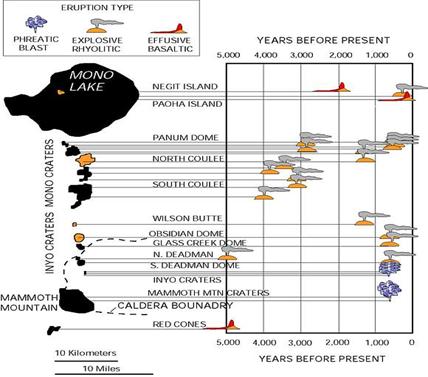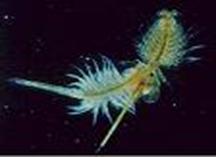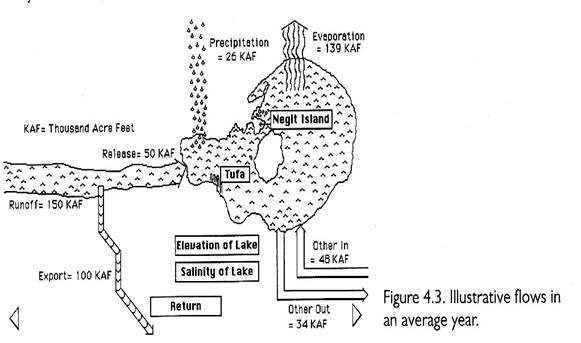Geology and Natural Heritage of the Long Valley Caldera
The Mono Basin: A History of Extremes
Jackie Duemler
ABSTRACT
The Mono Basin has one of the most eventful histories of volcanism in the United States. It is surrounded on all sides by monumental and volcanic landforms, the Sierra Nevada Mountains, the Basin and Range, Long Valley Caldera and the dormant Bodie Hills. It is host to the Mono Craters, the youngest mountain range in North America, as well as Black Point, the only underwater volcano that is fully exposed. The Mono Basin also holds Mono Lake, the focus point of the controversial 1979 California water war. It is because of the Basin’s unique volcanic history as well as its diverse human record that make this area in Eastern California one of the most geologically and historically reputed areas in the United States.
Geology of Mono Basin
For hundreds of millions of years the Mono Basin has experienced volcanic activity as a result of its dynamic location near the both the Sierra Fault zone and the Owens Valley fault zone (USGS). The unique topography of eastern California is defined by this extensive history of volcanism and to this day the area is still developing as a result of the geological process of plate movement and resulting volcanism. The Bodie Hills and the Anchorite Hills surrounding east of the basin are remnants of ancient volcanoes that have been inactive for millions of years but are still clearly visible, making them some of the oldest evidence of geologic history in the area. More recently, around 400,000 years ago, a series of volcanic eruptions following the Mono-Inyo Crater chain began spewing basalt and andesite into the western edge of the caldera, greatly affecting the caldera's geological composition. These explosions continued northward and eventually covered the Mono Basin region in volcanic debris around 40,000 years ago (Monolake.org). These explosions were common for thousands of years following the Long Valley eruption that occurred nearly 760,000 years ago. Throughout time, many features and landforms such as coalesced domes and craters have been created as the chain erupted. Results of volcanic activity include the southern lying Mono Craters, Panum Crater, Black Point, as well as Negit and Paoha Island.
Mono Basin lies to the east of the basin and range area in Eastern California and is bordered on the west by the Sierra Nevada frontal fault. The famous gold hills of Bodie lie to the north, the Cowtrack Mountains to the east, and Long Valley Caldera to the south. The mono basin region has been down dropping in reference to the Sierra Nevada 's for approximately 3 million years as a result of block faulting (Wetmap).
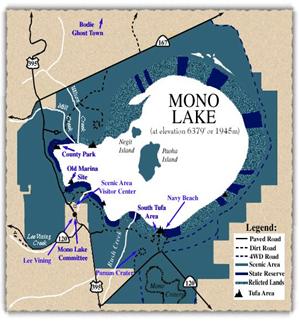
(Map of Mono Basin. Courtsey of Monolakeorg)
The Mono Craters
The Mono Craters are the oldest of these landforms and were formed between 40,000- 60,000 years ago as numerous high-silica rhyolitic eruptions inundated the area, creating a chain of obsidian and rhyolitic domes which reach almost 2,400 feet off the valley floor. Now dormant, the Mono Craters currently are the youngest mountain chain in North America (Sierraweb). For the past 2,000-3,000 years the Mono-Inyo Craters have been erupting in approximately 500 year intervals, the most recent of these eruptions occurred in 1850 and resulted in the creation of Paoha Island (Monolake.org).
Paoha and Negit Islands
Poaha Island was formed 230 years ago as rising magma forced lake sediment on the bottom of Mono Lake to the surface, forming a volcanic dome. Currently, Paoha is still a volcanically active site. Steam vents and hot springs are evident throughout the lake, confirmation that Poaha is not dormant (Molossia).
The other volcanic island that resides in Mono Lake is Negit Island , a black cinder cone which first erupted around 1,600 years ago when the lake was nearly 60 times larger than it is today. The volcanic Negit most recently flowed around 270 years ago.
(History of volcanic eruptions in the Mono Basin and surrounding area. Courtesy of US Geological Survey)
Panum Crater
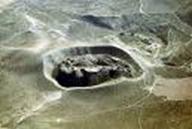
Ariel View of Panum Crater. Courtsey of James Bowson
The most recent volcanic and northerly eruption in the Mono Basin occurred when Panum Crater, a rhyolitic plug-dome volcano, exploded suddenly 640 years ago as a result of magma coming into contact with water, causing the water to expand and become highly pressurized steam, causing the volcano to explode so forcefully that a large crater was produced. Slowly, the magma that was still contained beneath the surface began to rise until it reached the surface where it hardened, forming a dome. This dome forming process occurred many times, each dome forcing the previous dome off the top to tumble into pieces below, eventually creating the immense buildup of volcanic rubble that forms the mountain that stands today.Black Point
Black Point is presently located near the northwestern shore of Mono Lake and enables any person willing to brave its black sands and steep hills a superb view of Mono Lake, though when it erupted 13,000 years ago, it was not located on the shore of Mono, but was completely submerged in the much deeper and expansive lake. It is because of this complete submersion beneath the water that the basaltic landform has wide fissures. The fissures formed when the water of the lake immediately quenched the heated lava, leaving fissures as deep as 80 ft in some spots (Sierraweb).
Reason Behind Mono Basin Volcanism
The immense dynamics of volcanism in the Mono Basin are a result of magmatic dikes intruding beneath the Mono Craters as a result of increased crustal stretching. Currently, it is believed that these dikes are now shouldering the excess strain once accommodated by the frontal faults that bound the basin area. These dikes have been responsible for 1mm per year extension for the last 40,000 years (Bursik).
Mono Lake
Mono Lake, a terminal lake of eastern California lies on the western edge of the Basin and Range region and to the east of the Sierra Nevada Mountains . It is estimated to be between one and three million years old (USGS) and has been a water source for an estimated 700,000 years. The discovery which resulted in this estimate was found by accident in the beginning of the twentieth century as oil workers drilled through several hundred feet of sedimentary rock on Poaha Island . Beneath this sedimentary rock the drillers discovered a layer of volcanic ash which dated to the Long Valley eruption that occurred around 760,000 years ago, and which covered another layer of sedimentary rock, establishing that this lowest layer of sediment is older than 760,000 years (Monolake.org). Mono Lake is also spans nearly the entire Mono Basin and often the basin itself is defined as the area surrounding Mono Lake and its contributing creeks.
History of Mono Lake
Around 23,000 to 12,500 years ago during the Pleistocene Era the vast glaciers that previously had blanketed the area began to melt rapidly, adding great amounts of glacial melt to the existing water sources, including Mono Lake . As a result of the increased water supply, Mono Lake rose to its highest water level in history, filling the basin until the water overflowed into the Owens River Gorge to its south, eventually flowing into Convict Lake in Owens Valley (Mossila). After this point the water level in Mono Lake began to sink, and as of yet the water level has never been high enough to reach this outlet again. As a result of the decreased water level, Mono Lake cannot reach any other water source which could carry the water out of the lake and so is a terminal lake that must depend on evaporation as its only method of water drainage. It is due to the lack of flow out of the lake and the slow evaporation of water that causes the salinity of the water in Mono Lake to be 2-3 times greater than the ocean. As water evaporates, the denser minerals and elements that were brought in with the run-off are left behind and become very concentrated, making the pH level of Mono Lake a 10 on a scale of 14.
Settlement History of Mono Lake
Though it is uncertain exactly when people began to inhabit the Mono Basin , it is believed that the area around the highly saline Mono Lake was inhabited as early as 5,500 years ago by the Kutzadika people (Wetmap). The harsh environment posed a great challenge to survival but the Kutzadika's prevailed for thousands of years on the shores of Mono Lake . Their diet consisted of water birds which populated the area in the summer seasons and the Alkali fly larva from which the name “Kutzadika” or “fly eaters” originates. Each fly larva is around 15 calories (monolake.org) and this type of food was collected by sweeping tightly woven baskets on the surface of the shallow alkaline water near the shore. The tribe of nearly 200 would depart from the lake during the autumn when both fly larva and the migratory birds disappeared from the area. The Kutzadika would then seek food in the nearby woods, hunting small game and collecting roots, berries and Pinyon nuts (Wetmap).
The Kutzadika were the lake's only human inhabitants until 1852 when a group of European Americans stumbled upon gold and silver ore in the northern hills surrounding Mono Lake . As word spread, settlers rushed to the area with dreams of gold and riches. Soon the mining towns of Bodie and Aurora were founded and as the mines greeded for wood, the forests in which the Kutzadika lived in the colder months were quickly logged to meet the increasing demand for timber. The Kutzadika's food supply dwindled as a result of the deforestation and they were forced to find work at the mines or in the surrounding countryside. Slowly the Kutzadika lost the land that they had lived on for thousands of years. Currently only a handful of Kutzadika people remain (Wetmap).
Ecology of Mono Lake
This intense salinity of Mono Lake puts a large strain on any organism attempting to live within its waters. Legendary writer Mark Twain even went so far as to say that Mono Lake was the “Dead Sea” of California (Monolake.org). Though this statement would initially seem to be true considering the harsh living conditions and salinity of the water, with one glance upon the lake in summertime one would discover that the lake is far from dead. An entire ecosystem survives beneath and above the waters of the lake, beginning under the water with algae and ending on the lakes' surface as the predators of the lake, birds, eat their fill of the organisms that are dependant on the algae as a source of food. These algae dependant organisms are alkali flies and brine shrimp, both which are abundant in the lake, brine shrimp numbering almost 4-6 trillion (Monolake.org) and flies breeding so densely in the spring that they form dense black clouds as they fly (Ranger Dave). As a result of the gigantic population of each species,
(Brine Shrimp. Courtesy of Mono Lake.org )
Mono Lake is an excellent food source for birds, for it is not difficult to catch the necessary amount of shrimp or flies necessary to survival when the prey is so numerous. ird species that take advantage of this unique environment and its abundance include Snowy Plovers, Eared Grebes, Wilson 's Phalaropes and Red-Necked Phalaropes as well as nearly 80 other species of water bird. Mono Lake is also a nesting ground for 50,000 California Gulls during the spring. That number constitutes 85% of the California Gulls breeding population, making it the second largest community in the world (USGS). This number of nesting gulls dropped significantly in 1977 when the water level of Mono Lake dropped, exposing a land bridge between the gulls favorite nesting island and land, making it possible for coyotes and other predators to take advantage of the large amounts of eggs and chicks present on the island.
Tufa
The soaring tufa towers of Mono Lake are one of its most unique and memorable qualities. These large formations grow up to 30 feet tall and seem to spring up from the shallow water near the shore of the lake in grays streaked with reds and yellows. Tufa towers like those in Mono Lake are unique because the tufa forms as calcium and carbonates meet and precipitate, creating limestone. This is generally a mixture that is rare in lakes, but due to the waters inability to flow out of the basin, the salinity of the water is extremely high and as the water evaporates, carbonates that would usually be carried out through streams are left behind. These carbonates then mix with the calcium rich springs that reside beneath the water and slowly begin to form calcium carbonate, or tufa. It takes centuries for tufa to grow as high as 30 ft because only a very small amount of calcium carbonate is made at a time, slowly building up on top of other segments of limestone as time passes, sometimes mixing with iron oxide during crystallization, creating the reds and yellows that streak the tufa towers. At Mono Lake there are still tufa towers dating back to the ice age, though they are not still growing since the water level of the lake has sunk hundreds of feet since that time. Currently, the water level has decreased again, but this time due to the 1941 water diversion that lowered the lake level by shutting off streams that flowed into Mono and is the reason tufa is presently visible.
(Mono Lake Tufa . Picture courtesy of Monolake.org)
1941 Water Diversion
In 1941, the city of Los Angles began searching for other sources of water to meet the growing city's need. It found what it was looking for in creeks of the Mono Basin such as Rush Creek and Lee Vining Creek, which are two of the five main water sources that once flowed into Mono Lake . An aqueduct was built and the diversion of water from the creeks began. Very quickly the decreased amount of water flowing into the lake began having tremendous effects on Mono Lake . The water level sank from 6,417 ft above sea level to 5,838 ft above sea level, resulting in a loss of 27 square miles of lake area by 1982 (USGS). This decrease led to evaporation in the lake exceeding input, further decreasing the water level while increasing the salinity and alkalinity of the lake. This change in salinity had a devastating effect on the Mono Lake ecosystem. The new environment was too salty for the brine shrimp, causing a die-off which in turn affected the masses of birds which traveled to the lake each year to feed off the shrimp. The decreased water level also exposed a land bridge to Negit Island , a nesting ground for birds, allowing predators such as wolves onto the island for the first time. The entire ecosystem would have faced extermination had the diversion continued . The following diagram shows the diversion of freshwater inputs to Mono Lake .
(Diversion of Freshwater Input. Mono Basin Research.org)
Court Battle
Changes in ecology became noticeable due to the water diversion and societies concerned with environmental welfare such as the National Audubon Society, Friends of the Earth, the Sierra Club, and the Mono Lake Committee began to look for the culprit behind the ecological devastation. In 1979, with the spirited David Gaines at their head, the societies joined together in an attempt to stop the Los Angles water company and sued the city, citing the Public Trust Doctrine. The Superior court agreed with them, saying, “It is an affirmation of the duty of the state to protect the people's common heritage of streams, lakes, marshlands and tidelands” (Hoover Institute).
After a long and intense fight the California State Water Board issued new laws concerning the Mono Lake water diversion. In 1994 all water diversion was stopped until the waters of Mono Lake rose to the specified 6,392 ft above sea level. Minimum flow levels were put into effect, making it so that water could only be removed from the creeks if they had a specified amount of water. Stream restoration plans were also put into effect, so that creeks such as Parker that had been nearly dried up could resume their natural flow. The following chart displays the changes in elevation, exposed area, and salinity of Mono Lake from 1941 to 2002.
Elevation
Lake Area
Exposed Lakebed
Salinity
When
6,417
55,179 acres (86.2 sq. mi.)
0 acres
51.3g/l
1941, prior to diversions
6,392
48,474 acres (75.7 sq. mi.)
6,700 acres
69.3g/l
stabilization level in 20 years
6,383
45,133 acres (70.5 sq. mi.)
10,000 acres
79.6g/l
2002
6,372
36,728 acres (57.4 sq. mi.)
18,500 acres
99.4g/l
1982, lowest recorded elevation
(Past lake fluctuations. Courtesy of Monolake.org)
Conclusion
The Mono Basin has been witness to monumental events in human history such as the initial inhabitant of the Kutzadika people 5,500 years ago, and the more recent 1941 water war over Mono Lake . The Basin also has born witness to the diverse volcanic activity that defines eastern California . Mono Basin itself was created by faulting associated with volcanic activity, while other volcanism created the Mono Craters and the islands of Paoha and Negit in Mono Lake . The basin also hosts an entire ecological system that is dependant on the peculiar saline and alkaline composition of Mono Lake. The Mono Basin is one of the most geologically and historically diverse areas in North America and its history of volcanism is far from being finished.
Bibliography
1. U.S. Geological Survey, Mono Lake website: Geologic History of Long Valley Caldera and the Mono-Inyo Craters volcanic chain, California : http://lvo.wr.usgs.gov/History.html2. Mono Lake Committee:Brine Shrimp, Mono Lake 's Unique Species: http://www.monolake.org/
3. The Sierra Web: Inyo-Mono Craters, A majestic landscape. http://thesierraweb.com/
4. Molossian Institute of Volcanology: Mono Craters Volcanic Field: http://www.molossia.org/volcanology/mono.html
5. Mono Basin Ecosystem Study Committee: Mono Lake Background Information: http://www.wetmap.org/Mono_Lake/Supplement/ml_background.html
6. Bursik, 2003, A volcanotectonic cascade: Activation of range front faulting and eruptions by dike intrusion, Mono Basin-Long Valley Caldera, California . M. Journal of Geophysical Research vol.108B, NO.8-9.
7. Wood,Spencer H, Distribution, Correlation, and Radiocarbon Dating of Late Holocene Tephra, Mono and Inyo Craters, Eastern California, JAN 1977
8. Hoover Institute. The Battle Over Mono Lake http://www.hoover.org/publications/digest/4559542.html
9. Mono Basin Research Institute. Geologic History of Mono Basin . http://www.monobasinresearch.org
